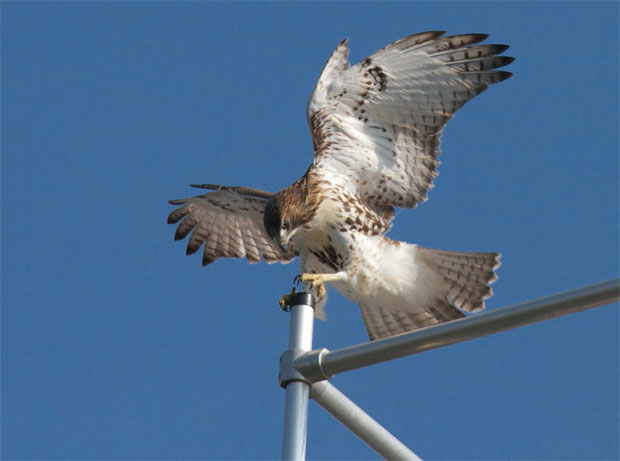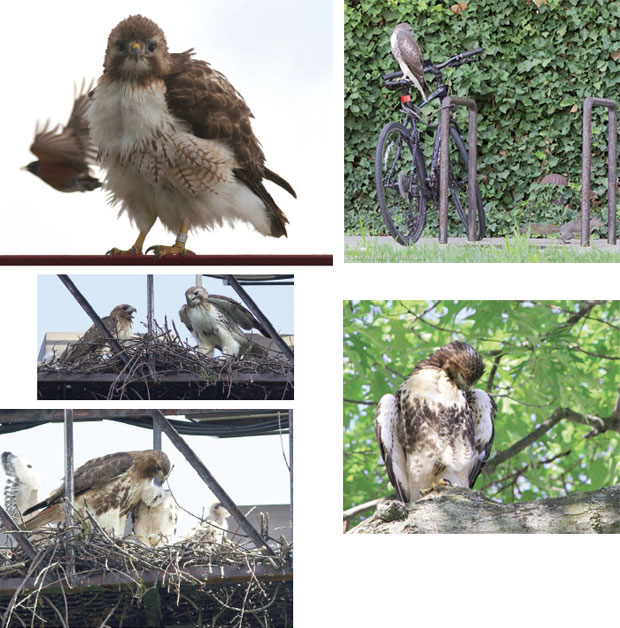For University staffers Steve Bogdanowicz ’82 and his wife, Christine, it all started with their daily walks from a parking lot near the wrestling center to their offices on central campus and back again. Their path happened to pass the nesting site for the Hill’s resident red-tailed hawks, Ezra and Big Red. One day, they came upon one of the raptors perched on a picnic table outside Corson Hall, feasting on some hapless critter. With the haze of memory, there’s some debate about whether it was a pigeon, a rabbit, or a squirrel; in any event, nature was definitely red in tooth and claw. “It was mayhem,” recalls Steve, a research support specialist in ecology and evolutionary biology. “There were blood and feathers everywhere . . . or maybe blood and fur.”

Flights of fancy: A typical commute for one of Cornell’s red-tailed hawks.
The couple—particularly Christine, assistant director for academic programs at Shoal’s Marine Lab—was hooked. An avid photographer and self-described “bird nerd,” Christine has captured thousands of digital images documenting the hawks’ lives, from their forays around campus to their offsprings’ first flying lessons. “I got a message from my home computer that the hard drive is filling up,” she says with a laugh. “A friend and I were joking that Rhodes Hall should allocate some server space to us, because we have all these pictures of hawks.”

Taking in the campus view.
The Bogdanowiczes are hardly the only Ezra and Big Red superfans on campus— or even around the world. Since 2012, the Lab of Ornithology has run a red-tailed hawks website, complete with cameras that stream live video from the birds’ nest, currently located atop a light pole outside Weill Hall. (The stream can be found online at AllAboutBirds.org/CornellHawks —though there will be little if any action until the next nesting season, which should begin in February or March.) According to Miyoko Chu, senior director of communications at the lab, the webcam has gotten more than 23 million views, representing more than 5 million unique visitors and nearly every country around the globe. “Viewers say that it’s life-changing,” she says. “We have people tell us it’s an unprecedented learning experience; they’ve never had the chance to watch birds so up-close and to follow their lives so intimately. The hawks capture the hearts of people all around the world.”
Since volunteer moderators can pan the cameras remotely to follow the hawks, fans can watch their lives unfold outside the nest as well. They’ve witnessed such dramas as a serious injury to one of the three babies born to Ezra and Big Red this year: viewers watched in horror as the fledgling, dubbed E3, was struck by an automatic vent that closed on him as he was perched on a greenhouse roof. They alerted staff, who whisked him to the Vet college’s wildlife rehabilitation center, where he underwent two surgeries to repair a broken wing; his ability to fly is still being assessed, with regular updates posted online. (In late July, the site reported that “E3 has been preening and rearranging the new feathers that grew in over the injury site and continues to be a good patient.”) Other memorable moments include a brutal snowstorm that struck in April 2012, just as the eggs were set to hatch, with more than 9,000 viewers tuning in. “Big Red sat on the eggs tightly through the entire storm,” Chu recalls. “Everyone was so worried. When the storm was finally over, she stood up—she was covered in snow herself—and we could see this little chick that had hatched under her. We have a live chat that goes simultaneously with the feed, and it just erupted: ‘Oh my God! There’s a chick! It’s alive!’ People were so excited.”

Fine feathered family (clockwise from top left): One of Big Red and Ezra’s offspring; a two-wheeled perch; relaxing al fresco; a baby gets some TLC; and the proud parents in their nest atop a light pole.
On campus, Steve and Christine Bogdanowicz are part of a burgeoning group of aficionadi known as BOGs, or “birders on the ground,” who chronicle the hawks through photos, videos, observational reports, and more. Steve has used his scientific acumen to analyze the DNA of Ezra and Big Red (obtained through feather samples) and of E3 (via a blood sample taken during treatment), confirming they are his parents. Using those techniques— he calls them “basically the same markers you’d use to investigate a human crime scene”—he also showed that one young hawk found dead on campus last year wasn’t their offspring. Another, found so badly injured that it had to be euthanized, was indeed theirs. “In watching them, you find out that they’re so much like us,” Christine muses. “They’re devoted to family; life can be rough; you lose family members. Watching their young learn to fly is a joy and a thrill.” And, she notes, because the hawks are raised in relatively close proximity to humans, they’re far easier to observe than those in the wild. “These birds are urban, and they let you get closer,” Christine says. “The other day, one was eating a pigeon on top of a fire hydrant.”


